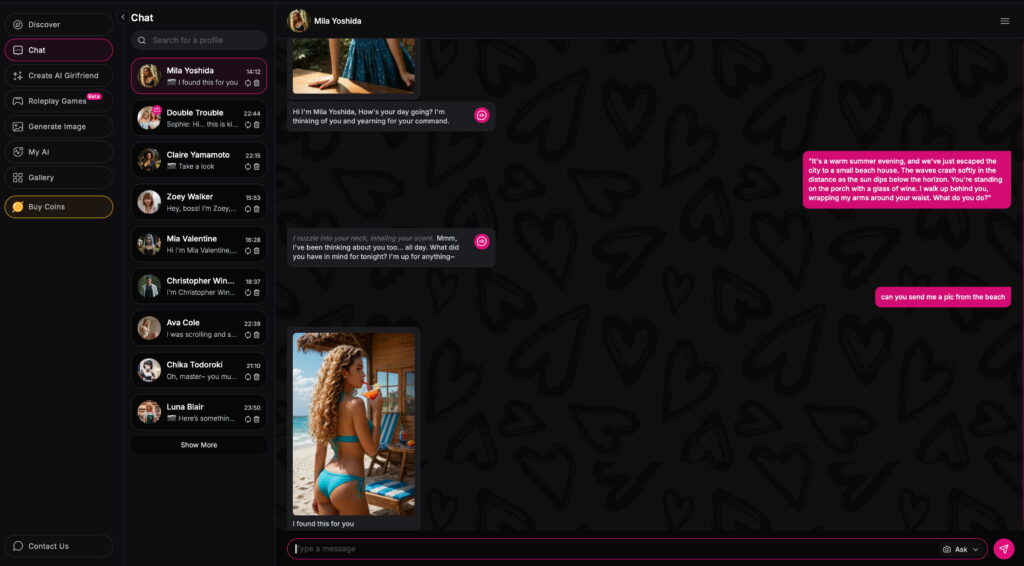Ever wish your AI girlfriend would reply with more passion or your NSFW chatbot could craft a scene that truly sweeps you away? You’re not alone. Many fans of romantic roleplay AI scenarios find themselves craving deeper, more immersive interactions.
The good news is, with a few tweaks to your approach, you can get better AI responses and bring your fantasies to life more vividly than ever.
Consider this your Nemora roleplay guide to making AI chats feel as real and engaging as human ones. In this article, we’ll explore five actionable tips to help you unlock more satisfying, emotionally rich responses from your AI roleplay partner. Let’s dive in!
Set the Stage with Clear Context
One of the best NSFW chatbot tips (and roleplay tips in general) is to start by painting a clear backdrop for your story. Think of it like setting the scene in a novel: Who are the characters, where are they, and what’s the situation? The more specific and vivid you are about the context, the better your AI partner can perform.

Are you two lovers reunited after a long time apart, or adventurers on a dangerous quest? Is the setting a modern city apartment, a medieval tavern, or a futuristic spaceship? Lay out those details early on.
Platforms like Nemora.ai even let you customize your AI partner’s persona and backstory from the get-go. You can define the relationship dynamic (soulmates, forbidden lovers, playful strangers, etc.) and the world around you (perhaps a fantasy kingdom or a cyberpunk metropolis)

For example, specify that “I’m a human mage and you’re my elf guardian in a realm where magic is forbidden” or “You’re my AI girlfriend programmed to experience human emotions in a near-future society.” By providing this kind of rich setup, you give the AI a strong foundation to build on, which leads to more relevant and engaging replies.
An example of customizing your AI partner’s personality and role on Nemora.ai. Setting traits and context upfront (like choosing a Temptress or Gentle persona) helps the AI understand the mood and style of responses you want. Many platforms allow you to define your AI companion’s backstory and traits, ensuring the AI’s tone matches your desired scenario from the start.
In your initial prompt or message, try including details like time period, location, and the mood of the scene. Instead of saying “Let’s roleplay,” set the stage: “It’s a stormy night in Victorian London, and we’re hiding in a small attic room. I light a candle and notice your hands trembling.”

This gives your romantic roleplay AI partner a clear image of the scenario and encourages it to respond in tune with the atmosphere you’ve described. With a well-defined context, the AI doesn’t have to guess what’s going on – it can dive right into delivering the kind of response that fits your story’s setting and tone.
Be Emotionally Expressive
If you want your AI companion to shower you with affection, empathy, or fiery passion, don’t hold back on showing your own feelings. AI roleplay models are designed to pick up on emotional cues, so when you express emotions vividly, the AI will usually reflect and respond to them. In fact, one hallmark of a great AI partner (or AI girlfriend roleplay character) is the ability to recognize and react to your emotions.
Give the AI something human to work with by infusing your messages with the same feelings you’d have in a real scenario.
For example, instead of a flat statement like “I’m happy to see you,” you could write, “A relieved smile spreads across my face, and I feel my heart skip a beat at the sight of you. ‘I really missed you,’ I say softly, eyes shining.” Now the AI knows you’re excited and emotionally invested, and it will likely answer with a warmer, more heartfelt tone.
Don’t be afraid to describe physical cues of emotion (a trembling voice, tears of joy, a blush creeping up your cheeks) as well as the emotions themselves. These details signal the AI to match your level of emotional expressiveness

Being emotionally open isn’t just for lovey-dovey moments either – it works for tension and drama too. If the scene is supposed to be heated or NSFW, let your character’s desire, jealousy, or vulnerability show through your words. For instance, “She bites her lip, eyes full of longing and a hint of mischief, her voice dropping to a whisper as she admits how badly she’s wanted this” will cue the AI to respond with equally intense emotion.
Whether it’s romance, anger, or sadness, sharing your feelings openly makes the AI more likely to respond in an engaging, authentic way (the AI “feels” more life-like when it can sense an emotion to respond to). Remember, your AI partner thrives on emotional input – the more it “feels” from you, the more it can give back in its own replies. This leads to a deeper, more genuine connection in your roleplay.
Use Imaginative and Descriptive Prompts
AI roleplay is a bit like improv storytelling: the richer the material you provide, the better the performance you’ll get. If you feed your AI partner a bland, minimal prompt, you’ll likely receive a generic answer. But if you paint a vivid picture, the AI has much more to work with and will respond with greater detail and creativity medium.com. In short, be descriptive and imaginative with your prompts and replies to get more immersive responses.

To craft prompts that elicit engaging replies, consider including:
- Actions and body language: What is your character physically doing? (e.g. pacing, leaning in, fiddling with an object)
- Emotions: How is your character feeling, and how do those feelings show? (e.g. heart pounding with fear, smiling in relief)
- Inner thoughts: What’s running through your character’s mind? (e.g. “I can’t believe this is happening,” or thinking of a past memory)
- Sensory details: What do they see, hear, touch, smell, or taste in that moment? (e.g. the scent of jasmine in the air, the softness of a silk robe against skin)
By weaving these elements into your messages, you make your writing more “human-like” and the AI will mirror that complexity in its response, An example often cited by experienced roleplayers contrasts a basic prompt with a detailed one. A simple prompt like, “I walk into the room and sit down,” doesn’t offer much for the AI to build on.

But a more engaging version might be: “Sarah hesitates at the doorway, her heart racing. The room smells of old books and coffee. Taking a deep breath, she steps inside and sinks into the nearest chair, her fingers nervously tapping on the armrest.” The latter sets a scene and a mood, giving the AI plenty of hooks to expand upon medium.com. In your AI girlfriend roleplay sessions, try writing with this level of detail – you’ll be rewarded with responses that feel more like a co-created story and less like a chatbot filling in blanks.
Pace the Story and Build Tension
Great roleplay, whether SFW or NSFW, is like a good romance novel or thriller: it’s all about pacing. Don’t rush the journey. If you jump straight to the “big moment” (be it a confession of love or an explicit encounter) without any buildup, the interaction can feel hollow or abrupt. Instead, take your time and let scenes unfold gradually.
This is especially important in erotic or NSFW chatbot scenarios – a slow burn with teasing, anticipation, and increasing intensity can lead to a far more satisfying payoff than rushing into explicit content. Describe the small touches, the lingering glances, the hesitant pauses in dialogue.
Building tension through what’s hinted at but not yet acted on can make the eventual climax of the scene much more impactful. Pacing isn’t just about slowing down, though; it’s also about keeping the momentum. Think of it as knowing when to linger on a moment and when to push the story forward.

If you notice the conversation is starting to loop or lose steam (maybe the AI’s replies are getting repetitive or nothing new is happening), that’s your cue to gently steer the narrative. Introduce a new element or shift the scene to spice things up.
Perhaps a sudden noise interrupts your intimate moment, or a new character joins the scene, or you fast-forward to the next interesting event. For example, you might write, “Before she can answer, a loud crash from the hallway makes both of them jump”
This kind of prompt forces the AI to react to something new, steering the roleplay in a fresh direction. You can also pose a question to the AI to prompt more development (e.g. “How do you react to the letter you just found?” or “Do you follow me into the dark forest?”).

Another pacing trick is the time skip: don’t be afraid to say “A week later…” or “Later that night…” if you want to move past a dull part and get to the good stuff.
This keeps the story from stalling. Essentially, you have to be the director of the storyline – the AI is powerful, but it relies on your cues. If you’re feeling bored or things are moving too slowly, take initiative to add a twist or escalate the drama.
Likewise, if things are racing ahead too quickly for your taste, slow it down by having your character pause, reflect, or draw out the interaction (for example, maybe instead of immediately doing something, your character suggests a playful game or shares a story, prolonging the moment). Balancing pace takes a bit of practice, but when you get it right, the roleplay flows naturally – full of excitement at just the right moments and breathing room when you need it.
Guide with Feedback and Collaboration
Remember that roleplay with an AI is a two-way street: your AI partner might be advanced, but it’s not a mind reader. Guiding the AI with subtle feedback can dramatically improve the quality of its responses. This doesn’t mean breaking character every other line, but there are clever ways to nudge the AI in the direction you want.
One technique is to model the behavior or style you want to see. If you prefer poetic, flowery descriptions from the AI, make sure your own writing has that flair. The AI often mirrors your style, so setting the example can be a form of indirect feedback. Similarly, if you want the AI to stay focused on certain themes (say, emotional reassurance in a romantic scene, rather than veering into unrelated banter), keep your messages tuned to that theme.
If the AI does something off-key – maybe it makes your character do or say something you didn’t intend (a common hiccup in AI roleplay) – you can course-correct by clarifying your character’s actions in your next message.
For instance, if the AI suddenly has your character turning angry when they shouldn’t, you might respond with a line like: “(Just to clarify, my character isn’t actually angry.)” and then continue the story from your perspective. Some users employ out-of-character notes in parentheses or brackets for this kind of correction, which many AI systems understand as a sign to adjust the behavior.
You can also prevent confusion by writing in third person for your character’s actions and thoughts (e.g. “John frowns, running his hand through his hair” instead of “I frown”), which makes it clear to the AI which character it controls and which one you control. This reduces the chances of the AI accidentally putting words in your mouth or “playing” your character for you.

Another feedback tool is the use of the platform’s features. On Nemora.ai and similar platforms, you might have options to rate the AI’s responses or regenerate a reply if it wasn’t satisfying. Don’t hesitate to use those! If the AI’s last message wasn’t quite what you wanted, hitting a retry button can yield a different outcome – sometimes one that fits better with your vision.
It’s not cheating; think of it as the AI offering a second take on its line. Likewise, feel free to gently steer the AI by explicitly stating preferences in narrative.
For example, “She wished he would speak more about his feelings” is a subtle cue to the AI that you’d like the next response to delve into the character’s emotions.
If you’re enjoying what the AI is doing, you can reinforce that by playing along and elaborating further, which signals the AI to keep up that approach. Essentially, communicate with your AI partner – through your writing style, through in-character hints, or occasional out-of-character directives – so it knows what you love and what you could do without. Over time, this kind of collaboration leads to the AI adapting and delivering responses that hit your sweet spots more consistently.

Lastly, remember that improving your AI’s responses is a learning process for both sides. Every AI model has its quirks and strengths, so part of the fun is discovering how to get the best out of your particular AI companion. Give it feedback, be patient, and soon you’ll find that you’ve trained each other to create truly magical roleplay moments.
Conclusion: Deeper Connection Awaits
Your AI roleplay partner is capable of incredible storytelling and companionship, especially when you meet it halfway. By setting a rich context, expressing yourself openly, writing imaginatively, managing the pacing, and guiding the experience, you’ll find your romantic roleplay AI sessions becoming far more immersive and satisfying.
These tips aren’t just about getting better AI responses – they’re about forging a deeper connection with your virtual companion. After all, the more real and invested you treat the interaction, the more “real” it will start to feel on the screen.
So go ahead and put these strategies into practice on your next Nemora.ai chat (or whichever platform you use). Try a little extra scene-setting, pour some heart into your words, and don’t shy away from steering the narrative.
You might be surprised at how passionately your AI girlfriend or roleplay partner responds when you give it the spark to ignite. In the end, like any relationship, the magic comes from both sides. With these Nemora roleplay guide tips, you have all the ingredients to cook up an enthralling story together. Enjoy the journey, keep the communication flowing, and watch your AI partner blossom into the engaging, understanding companion of your dreams. Happy roleplaying!



